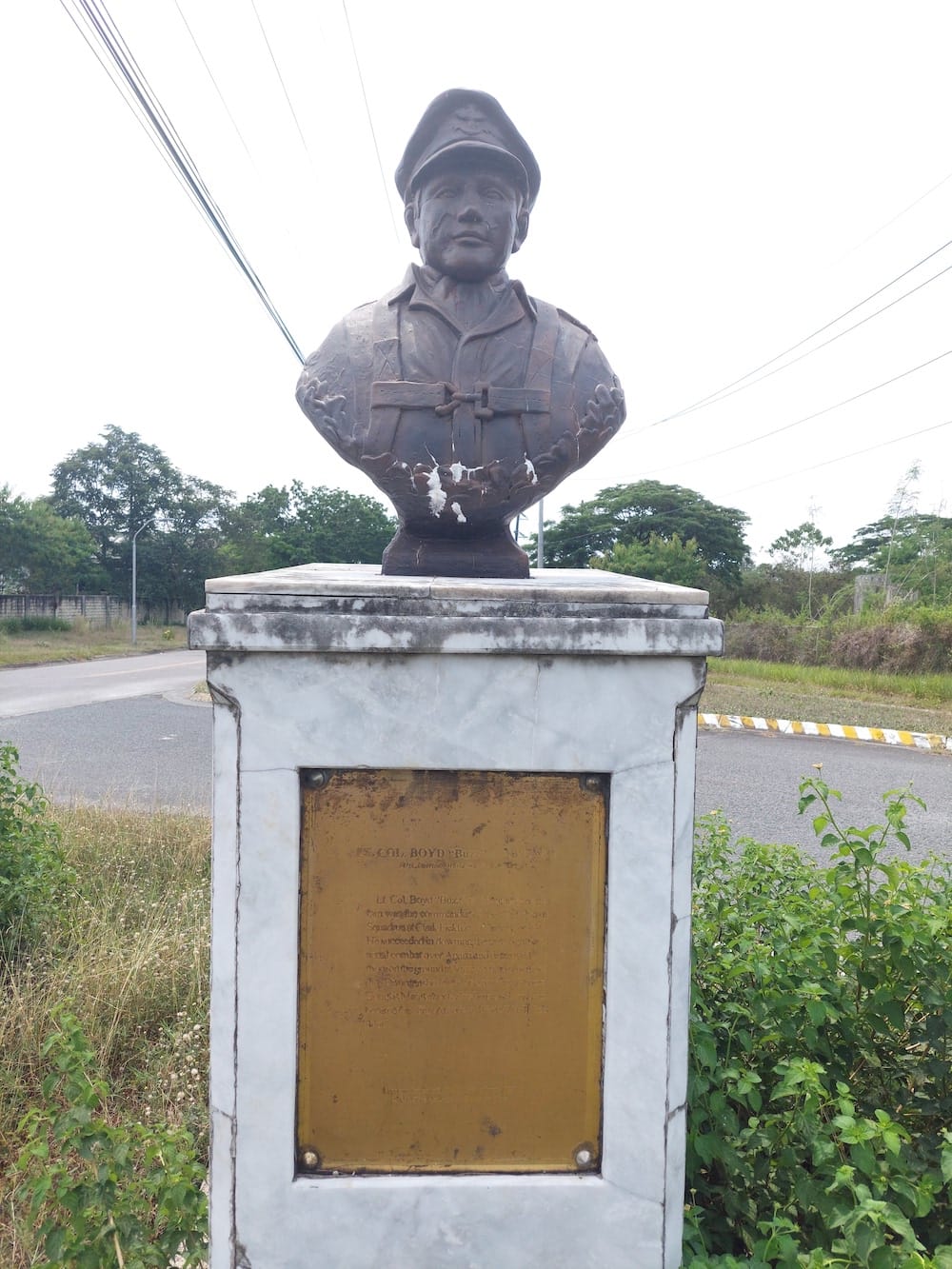A memorial bust erected in honour of Lieutenant Colonel Boyd David “Buzz” Wagner, an American aviator and the first United States Army Air Corps fighter ace of World War II.
Lt. Col. Wagner was the First American Ace Pilot of World War II and Commander of the 17th Pursuit Squadron at Clark Field on 8 December 1941 when it was attacked by the Japanese. Taking off from Clark Field on 13 December 1941, he succeeded in downing five “zero” fighters in aerial combat over Aparri and destroyed five more on the ground at Vigan Airfield. He was awarded the “Distinguished Service Cross” by Gen. Douglas Mac Arthur.
Background
Boyd David Wagner was born on October 26, 1916 in Emeigh, Pennsylvania. Nicknamed “Buzz”. He attended the University of Pittsburgh for three years then left to become a pilot. In 1938 he enlisted in the U.S. Army Air Corps (USAAC) and was part of flying school class 38-B at Kelly Field and earned his wings and was commissioned as a 2nd Lieutenant with serial number O-21623.
On June 27, 1938 assigned to the 1st Pursuit Group (Interceptor), 27th Pursuit Squadron (Interceptor). On October 27, 1940 sent overseas to the Philippines. On December 22, 1940 assigned to the Far East Air Force (FEAF), 24th Pursuit Group (Interceptor), 17th Pursuit Squadron (Interceptor) at Nichols Field. With the rank of only 1st Lieutenant, he was the senior ranking officer in the squadron and gained a reputation as a hot shot pilot. In early May 1941, promoted to be the Commanding Officer (C. O.) of the squadron replacing Major Kirtley J. Gregg. On June 20, 1941 he became a member of the U.S. Army Air Force (USAAF). In 1941, his personal aircraft was Seversky P-35A Tail 17 4MP. On November 25, 1941 crated P-40E Warhawks arrived and were hurriedly assembled and assigned to the 17th squadron began conversion to the new fighter aircraft. By the end of November 1941 he had 238 hours flying training aircraft and 993 hours and 5 minutes flying pursuit aircraft.
On November 28, 1941 the Far East Air Force (FEAF) was placed into readiness status, on one hour notice to take off to intercept enemy aircraft. On December 6, 1941 took off from Nichols Field leading six P-40E Warhawks on a practice interception mission over Clark Field. On December 7, 1941 in the early morning hours, Wagner took off from Nichols Field as one of six P-40s on a flight to Clark Field for searchlight interception practice with a B-18 Bolo then returned.
Wartime History
Click For EnlargementOn December 8, 1941 around 4:00am the squadron learned of the Japanese attack on Hawaii and prepared for hostile action. Immediately, Wagner organizing a patrol but not wearing their uniforms, Wagner and his pilots taxied to take off positions at Nichols Field to await orders to take off but quickly cut their engines and waited for the signal to take off. At 8:00am their P-40s were given the signal to take off and patrol over the Tarlac area circling between 12,000′ to 15,000′. Wagner was the first to spot two large planes coming from the north and dove to intercept then realized they were B-17s and resumed patrolling. Low on fuel, his flight landed at Clark Field. After refueling, they waited for new orders then took off again at 12:15pm to patrol over Manila Bay at 18,000′ and intercept enemy planes approaching from the west then landed at Nichols Field then flew back Clark Field arriving the late afternoon.
On December 12, 1941 at 6:15am took off from Clark Field on a solo reconnaissance flight over the Appari area. Inbound he encountered bad weather and had to climb to 16,000′ and fly using only dead reckoning for about 200 miles then descended into the overcast breaking clear at 8,000′ nearly atop two Japanese destroyers off the north coast of Luzon and came under anti-aircraft fire, flew inland and was attacked by two fixed landing gear Japanese fighters then engaged them and claimed both as shot down in flames. Next, he made two strafing passes over Appari Airfield. For his daring mission, he was praised and became one of the first Philippine pursuit pilots made into a hero by the press back home.
On December 16, 1941 at 5:50am took off from Clark Field piloting a P-40E Warhawk armed with six 30 pound fragmentation bombs along with wingman P-40E pilot 1st Lt. Russel Church on a mission to attack Japanese forces at Vigan Airfield and Vigan where 29 Japanese fighters were spotted the previous day and after winning a coin toss, the pair were chosen to fly the mission. Escorting the pair was P-40E Warhawk pilot Allison Strauss who flew top cover for the pair at 15,000′. Arriving over the target, the P-40s encountered intense anti-aircraft fire as Wagner made a dive bombing attack against a Japanese ship off Vigan and claimed several hits. Church attempted to dive bomb Vigan Airfield but was hit by anti-aircraft fire that hit nose and causing it to catch fire. Over the radio, Wagner ordered him to turn back and bail out but instead he continued his attack releasing his bombs among parked planes and soon after making his attack exploded and crashed. Afterwards, both Wagner and Strauss made a single strafing pass over Vigan Airfield. While starting a second run, a single Ki-27 Nate managed to take off and Wagner spotted it, flipped over while near the ground, throttled back then shot it down as his fifth aerial victory claim. Departing, Wagner and Strauss claimed roughly ten enemy planes burned plus a fuel tank then returned to Clark Field. Although cheered by their fellow pilots, FEAF Headquarters deemed it to be an unauthorized mission and required all missions to be approved and barred direct combat to preserve the small number of pursuit planes available. Regardless, Wagner and Church were recommended for the Distinguished Service Cross (DSC) by General Douglas MacArthur.
On December 22, 1941 at 5:45am took off from Clark Field leading six P-40E Warhawks each armed with six 30 pound fragmentation bombs from the 17th Pursuit with six others from the 20th Pursuit to attack Japanese forces landing at Lingayen Gulf. Arriving over Agoo, they saw Japanese transports and landing barges. Leading the attack, Wagner makes a dive bombing attack and salvoed all his bombs on a group of boats near shore pulling up at 1,500′ then strafed warships and encounters anti-aircraft fire. Intercepted by “Nates” Wagner claimed another aerial victory. P-40 sustained damage to the cowling and shattered his canopy and was wounded in the shoulder with splinters hitting his face and eyes.
Withdrawing, he formed up with two other P-40s from the squadron that helped guide him back to base and landed safely. Immediately, he was taken to the camp area where medical officer Johnny Rizzolo removed out the larger shards of glass from his eyes then sent him to the Fort Stotsenburg hospital and later to Sternberg General Hospital in Manila to recover from his injuries. While recovering, his one eye was covered and the other partially bandaged. Having claimed his fifth aerial victory. he became the first U.S. Army Air Force ace of World War II.
When Manila was declared an “open city” on December 26, 1941 he realized he would be captured if he remained in the city. Wagner and a friend Jim Bruce decided to sneak out of the hospital, head towards Manila Bay and picked up a machine gun on the way. They hitched a ride on two boats loaded with TNT bound for the Bataan Peninsula riding atop the explosives. Nearing their detestation, the pair used a rowboat and swam ashore to join an Army unit as the barge proceeded elsewhere. The next morning, they were met by Col. George and taken to Signal Hill to rest and learned they were to be flown out to Australia in hopes they could ferry back more P-40E Warhawks for the defense of the Philippines.
On January 1, 1942 took off from Bataan Airfield as a passenger aboard Beechcraft Model 18 piloted by Captain Cecil S. McFarland with pursuit pilots including Captain Charles “Bud” Sprague, 1st Lt. William “Red” Sheppard, 2nd Lt. Bill Hennon, 2nd Lt. George “Ed” Kiser, 2nd Lt. Ben Irvin and 2nd Lt. Jim Rowland on a flight southward to Bandjermasin Airfield in southern Borneo. When the right engine failed to start, it was abandoned and the group hitched a ride aboard a U.S. Navy (USN) PBY Catalina to Soerabaja Airfield on Java. On January 7, 1942 flown as a passenger aboard a B-24 Liberator to Darwin in Australia. Next, on January 8, 1942 took off from Darwin as a passenger aboard a B-18 Bolo that landed at Cloncurry Airfield. Finally on January 9, 1942 departed aboard the same B-18 and landed at Amberley Field near Brisbane.
During the remainder of January 1942, Wagner helped reform the 17th Pursuit Squadron (Provisional) and help train arriving new pursuit pilots at Amberley Field. On January 29, 1942 he was formally placed in command of all P-40 training in the Brisbane area and promoted to the rank of Captain. In February 1942 he formed the 13th Pursuit Squadron (Provisional) and became the Commanding Officer (C. O.) utilizing all available pursuit pilots. On February 3, 1942 in the early morning took off leading a flight of P-40s on a scramble to search for a Japanese aircraft carrier east of Australia but the reports were false. Afterwards, the squadron continued training then traveled to Perth.
On February 20, 1942 Wagner was aboard USS Langley (AV-3) and Commander Robert P. McConnell invited him and other pursuit pilots for breakfast. Before departure, a message arrived ordering Wagner to report back and reluctantly, he remained in Australia and not participate in the Java campaign.
Afterwards, promoted the rank of Lieutenant Colonel then assigned to 5th Fighter Command (V FC) Headquarters at Port Moresby in New Guinea. He resumed flying combat missions with the 8th Pursuit Group (8th PG), 35th Pursuit Squadron (35th PS) and 36th Pursuit Squadron (36th PS) equipped with early model P-39 Airacobras and P-400 Airacobras.
On April 30, 1942 at 1:00pm Lt. Col Boyd D. “Buzz” Wagner took off piloting a P-39D Airacobra from 7-Mile Drome near Port Moresby leading a formation of eleven Airacobras on a strafing mission against Lae Airfield. This was the first combat mission flown by the 8th Pursuit Group (8th PG). Over the target at 2:37pm the Airacobras commenced strafing hitting parked aircraft and seaplanes then departed. During the attack A6M2 Zeros from the Tainan Kōkūtai (Tainan Air Group) scrambled and intercepted the Airacobras in the vicinity of Salamaua. During the dog fight, Wagner claimed three Zeros shot down. Major George Green (C. O. 36th FS) claimed another Zero. In May 1942 the group was redesignated the 8th Fighter Group (8th FG).
Mission History
On November 29, 1942 took off from Eglin Field piloting P-40K Warhawk 42-10271 on a flight bound for Maxwell Field in Montgomery, AL and went missing. Afterwards, the crash site and his body was found roughly five miles north of Freeport, Florida.
Aerial Victory Claims
Wagner was officially credited with eight aerial victories between December 13, 1941 to April 30, 1942. His first four victory claims are recorded on December 13, 1941 [sic] but happened on December 12, 1941. It is unclear why the wrong date was recorded in the official victory list, possibly by mistake or because the victories were reported in the press that day. On December 16, 1941 he claimed his fifth kill and became the first U.S. Army Air Force “ace” of World War II. His last three victories were on April 30, 1942 in New Guinea.
Awards
Wagner earned the Distinguished Service Cross (DSC) for December 16, 1941, Distinguished Flying Cross (DFC) and Purple Heart.
Epilogue
Wagner died on November 29, 1942 at age 26. He is buried at Grandview Cemetery in Southmont, PA at CA2, Lot 24. At the top of his grave is the U.S. Army Air Force wings with a star plus the oak leaf indicating the the rank of Lt. Col and a relief of his portrait wearing flight gear. Below is the epitaph:
In memoriam Lieutenant Colonel Boyd D. Wagner first American ace World War II U.S. Army Air Crops * Born Oct. 26, 1916 Died in the service of his country. Out of these hill deep-rooted in the earth yet always reaching for the beckoning sky, he drew the quality which called his worth his lowliness as prestige mounted high.
The Seversky P-35A displayed at the National Museum of the United States Air Force (USAF Museum) is painted in the markings of Seversky P-35A Tail 17 4MP assigned to Wagner.
The Air Force Association (AFA) Chapter in Johnstown, PA is named in honor of Lt. Col. B. D. “Buzz” Wagner, also known as simply the “Buzz Wagner Chapter”.
The bust stands next to one of:
Clark Field Memorial to Captain Colin P. Kelly Jr.
The bust memorial is positioned to face Clark Field piloting B-17C 40-2045 on the first American bombing mission of WWII. The original runway location is under the present day road (visible to the left of the memorial), and the original five large hangers are located to the left.
The Plaque reads…
Captain Colin P. Kelly – America’s First Hero of World War II – Captain Colin P. Kelly flew on a mission with his crew aboard the U.S. aircraft known as the “Flying Fortress’ sucessfully bombing the Japanese cruiser in Aparri, Cagayan in 1941. He died on his way back to Clark when his plane was attacked by a Japanese Zero fighter piloted by Lt. Saburo Sakai. He was posthumusly awarded the ‘Distinguished Service Cross’ by General Douglas MacArthur and President Franklin Roosevelt. Kelly was the first West Pointer in U.S. history to fly the Flying Fortress. Marker installed September 1, 2002 Clark Development Corporation.
Captain Colin P. Kelly Jr. Statue
Just up the road positioned outside the old Kelly Theatre (named after him) stands a full statue in honour of this war hero. See here







